Table of Contents
Table of Contents
Hypoxic-Ischemic Encephalopathy (HIE) is a rare but serious condition that affects newborns, occurring when a baby’s brain doesn’t get enough oxygen and blood around the time of birth. While it isn’t common, HIE can have life-altering consequences, making awareness, early diagnosis, and proper care critically important.
HIE occurs when the brain is deprived of oxygen (hypoxia) and blood flow (ischemia), often during labor or delivery. The severity of HIE is typically classified into three categories: mild, moderate, and severe, and the outcomes can vary drastically:
- Mild HIE: Less than a 5% chance of a severe disability.
- Moderate HIE: A 25% to 75% chance of severe disability or early death.
- Severe HIE: Over 75% of cases result in a severe handicap or death.
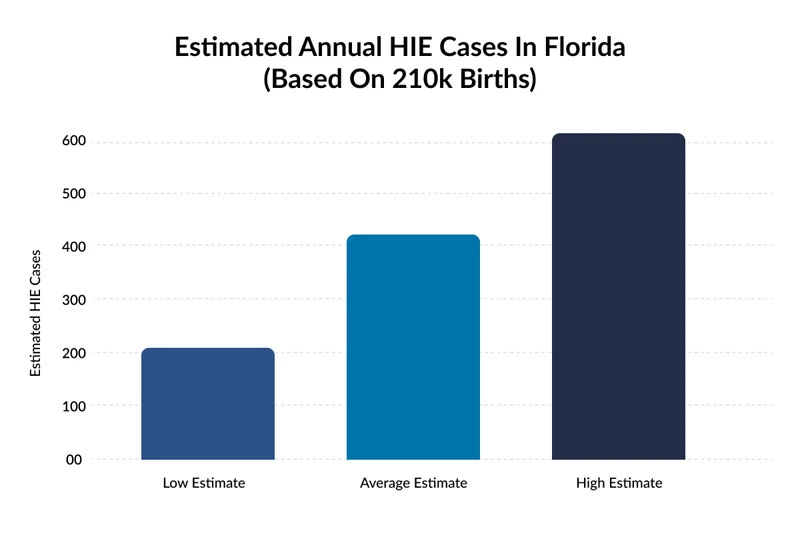
While the condition is rare, its impact is significant, especially for families facing the challenges of long-term care or loss.
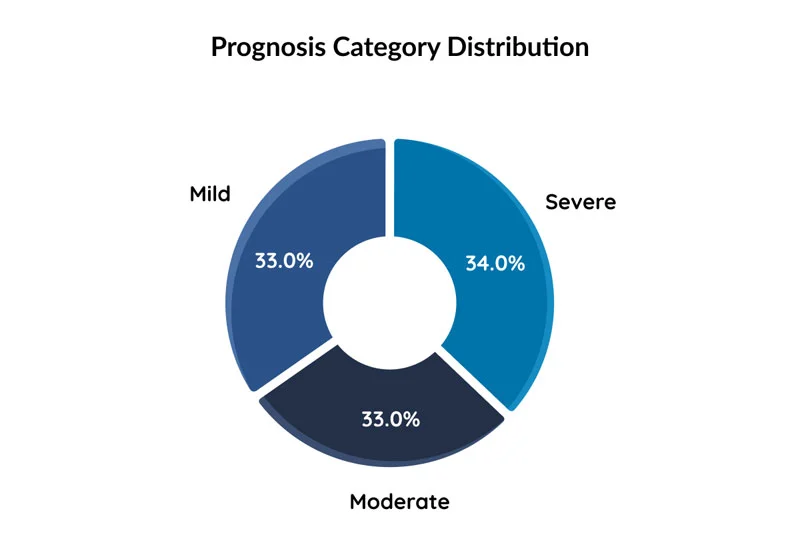
How Common is HIE in the U.S.?
Nationally, HIE affects approximately 1.7 out of every 1,000 live births, according to a cohort study conducted between 2012 and 2019. This aligns with previous estimates of 1.5–2.5 per 1,000 births for moderate to severe cases in developed countries.
In absolute numbers, that’s over 12,000 newborns affected by HIE each year in the United States. Although medical practices and monitoring during labor have evolved, the overall incidence of HIE has remained relatively steady in recent years.
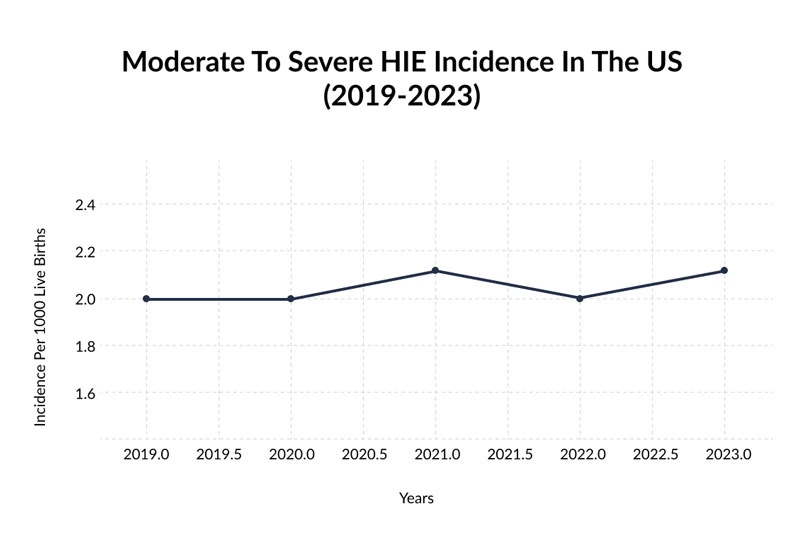
While the number of HIE cases hasn’t dropped dramatically, outcomes have improved thanks to advances in neonatal care. One of the most impactful treatments has been therapeutic hypothermia, a method of cooling the baby’s body to reduce brain damage.
As a result, survival rates and neurological outcomes are better than they were a decade ago. In fact, a large study of 32 million births showed that neonatal mortality from HIE dropped from 11–12% (2010–2012) to around 8–10% (2016–2018).
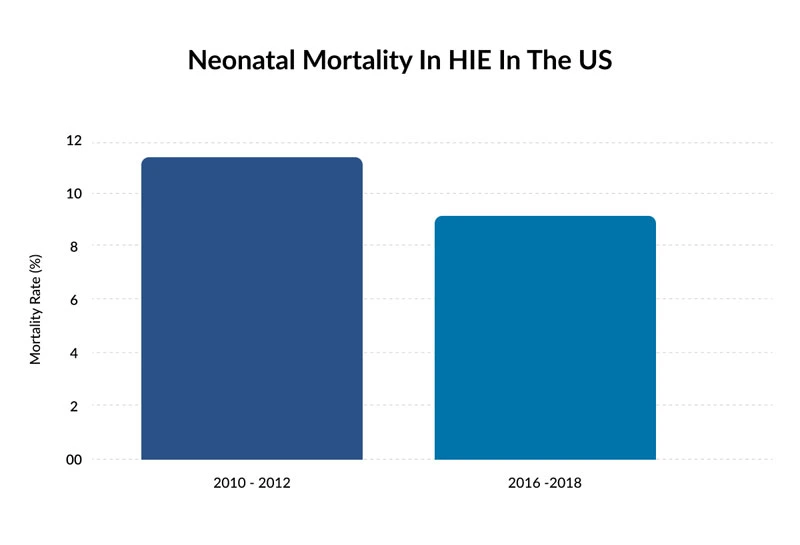
Hypoxic-Ischemic Encephalopathy (HIE) in Newborns: Florida Incidence and Trends (2019–2024)
According to estimates from the Florida Neonatal Neurologic Network, which operates under UF Health, anywhere from 3 to 20 full-term infants per 1,000 births in Florida are affected by HIE. This is a broad range, which reflects variability in data reporting and differences in hospital settings, population demographics, and risk factors across the state.
Florida sees about 210,000 to 220,000 births each year, meaning that even on the lower end of the estimated incidence, at least 300 newborns develop moderate or severe forms of HIE annually. On the higher end, that number may approach 600 infants per year. These are not mild or borderline cases. These are babies who typically experience significant oxygen deprivation during birth and require specialized, urgent medical care in the hours and days following delivery.
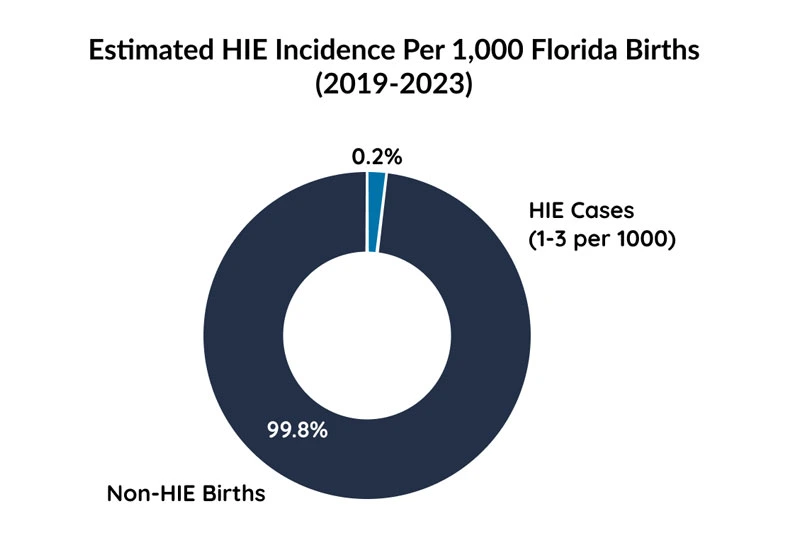
Infants with moderate to severe HIE almost always need admission to a Neonatal Intensive Care Unit (NICU) immediately after birth. One of the most critical and widely used treatments is therapeutic hypothermia, often referred to as “cooling therapy.” This involves lowering the baby’s body temperature within the first 6 hours of life, typically to around 33.5°C (92.3°F), for 72 hours.
This treatment slows down the baby’s metabolic rate. It helps minimize ongoing brain injury, giving the brain a chance to recover and potentially reducing the risk of long-term neurological complications.
NICU Trends and Hospital Data in Florida
Over the past 5 years, the overall trend in Florida has remained reasonably steady, both in terms of incidence and hospitalizations. This aligns closely with national data, where HIE rates have neither spiked nor dropped dramatically despite ongoing efforts in obstetric and neonatal care.

Hospital discharge data from the Florida Agency for Health Care Administration (AHCA) support this steady trend. These records confirm that several hundred newborns each year in Florida are hospitalized with HIE-related diagnoses. While detailed public data on these specific cases is somewhat limited, discharge coding (using ICD-10 codes P91.6x) allows for tracking at the state level.
However, it’s important to note that HIE is not a reportable disease in Florida, which means hospitals are not required to report cases to a central health authority in real time. Instead, diagnosis information is collected retrospectively through billing and discharge data, which can make surveillance and analysis more difficult.
NICU Admissions and HIE’s Share of the Burden
Florida’s NICU admission rate for all newborns has been steadily rising, increasing from 9.0% in 2016 to 9.8% in 2023, according to the CDC. That means nearly 1 in 10 Florida newborns spend time in a NICU. While HIE accounts for only a small fraction of these admissions, its clinical impact is disproportionately large.
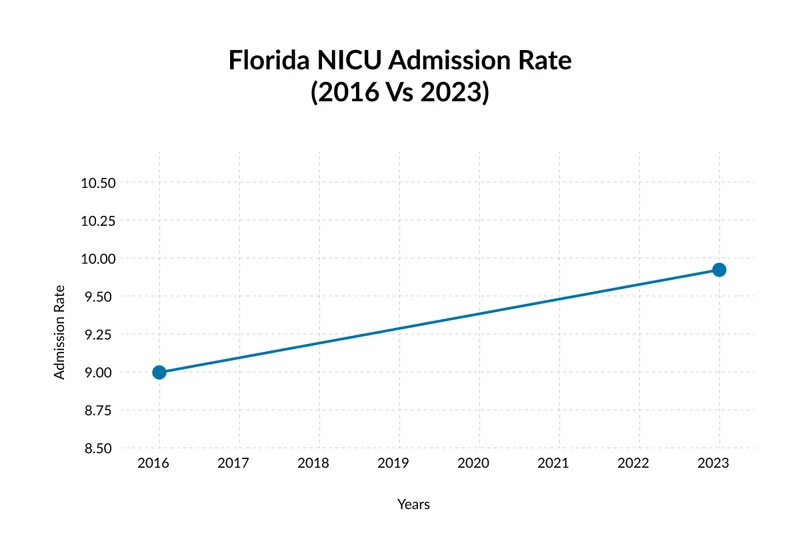
That’s because infants with HIE often have more complex needs, more extended hospital stays, and higher risks of long-term disability compared to other NICU patients. For example, using a conservative incidence estimate of 1 to 3 per 1,000 births, and applying it to Florida’s ~210,000 births in 2020, we’d expect between 210 and 630 cases of HIE that year alone.
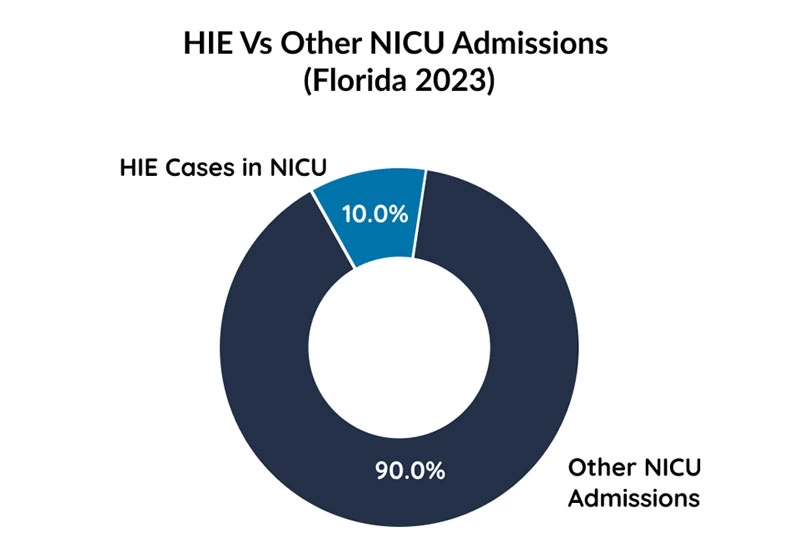
Are Florida’s Outcomes Improving?
Yes, but cautiously so. The prognosis for infants with HIE has significantly improved over the past decade, largely thanks to medical advances like cooling therapy and faster NICU response times. A nationwide study analyzing data from 32 million births found that neonatal mortality for HIE dropped from around 11–12% between 2010 and 2012, to 8–10% between 2016 and 2018.
This progress is promising, especially considering how devastating HIE outcomes once were. Still, challenges remain. Even with improved survival, HIE is still a leading cause of serious neonatal complications in Florida, including:
- Neonatal encephalopathy
- Seizures shortly after birth
- Cerebral palsy and other motor disorders
- Cognitive and developmental delays
Statewide Preparedness and Response
Most of Florida’s larger hospitals, especially those with Level III or Level IV NICUs, have formal protocols in place for managing suspected HIE cases. These protocols ensure timely identification and cooling treatment, which is critical, since every hour counts in the early management of brain injury.
Despite this, not all cases are preventable. HIE may occur due to a wide range of complications during pregnancy or labor, such as umbilical cord accidents, uterine rupture, placental abruption, or prolonged lack of oxygen during delivery. This makes early recognition and immediate neonatal support key factors in minimizing the impact of the condition.
HIE and Birth Injury Litigation: How Florida Compares to the Rest of the Nation
While Hypoxic-Ischemic Encephalopathy (HIE) is primarily a medical condition, it is also at the center of some of the most complex and high-stakes litigation in the U.S. healthcare system. Because HIE often results from complications during labor or delivery, many cases raise questions of medical negligence. When they do, they often lead to legal claims involving massive financial awards.
Let’s break down how HIE-related litigation plays out across the country and how Florida’s legal and compensation system stands apart.
The High Cost of Obstetric Malpractice
Obstetrics is one of the most litigious areas of medicine, and cases involving HIE or birth-related brain injury are often the most costly. These lawsuits are driven by the fact that children with severe HIE may require lifelong care, including therapy, assistive devices, medications, and accommodations for disabilities. As a result, the settlements and jury verdicts in HIE cases tend to be very high, often ranging from hundreds of thousands to several million dollars, and sometimes even more in extreme cases.
National data shows that malpractice payouts in the U.S. have remained substantial over the past five years. From 2018 to 2022, the country averaged $4–$4.5 billion in malpractice payouts annually, with 2022 alone seeing about $3.2 to $4.0 billion depending on the source (based on HRSA’s NPDB data). That same year, there were nearly 9,800 malpractice payment reports filed nationwide.
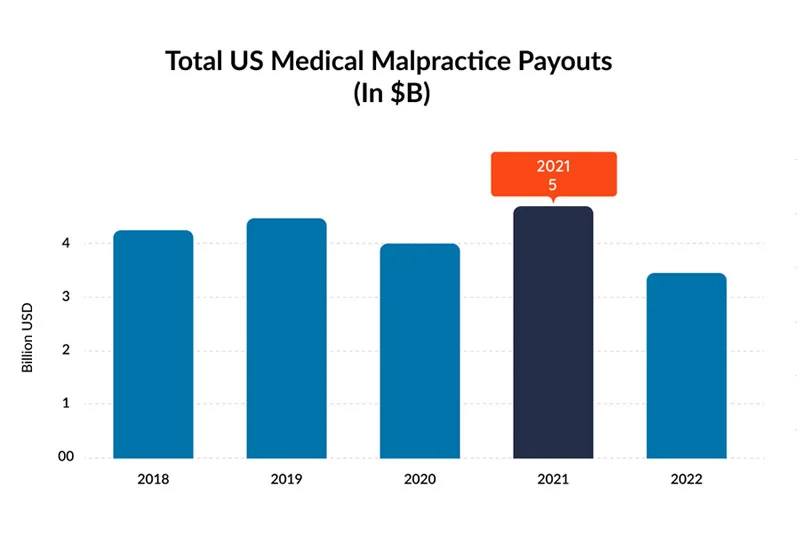
States like New York, Illinois, Maryland, and California have seen headline-grabbing jury awards, sometimes exceeding $50 million in individual HIE cases. While such verdicts are rare, they have a ripple effect: they encourage pre-trial settlements and push insurers to resolve cases quickly to avoid massive financial risk in front of a jury.
Florida’s Unique Legal Approach: The NICA Program
Florida has taken a distinctive path in handling birth injury claims, thanks to a program called NICA (Birth-Related Neurological Injury Compensation Association). Created in 1988, NICA was designed as a no-fault compensation system for families whose children suffer catastrophic birth injuries, including severe forms of HIE.
Here’s how it works:
- If a child qualifies for NICA, the family receives lifetime medical care and a one-time statutory award.
- In exchange, the family waives their right to file a malpractice lawsuit against the healthcare providers involved.
- The goal is to reduce costly litigation, stabilize malpractice insurance premiums for OB/GYNs, and provide reliable care for affected children.
Only one other state, Virginia, had a similar system, but it closed to new claims in 2021, making Florida’s NICA the only active program of its kind in the U.S.
As of early 2021, over 1,200 petitions had been filed with NICA by Florida families, and 440 children had been accepted into the program. This shows that many severe HIE cases in Florida have been handled administratively, rather than through the court system.
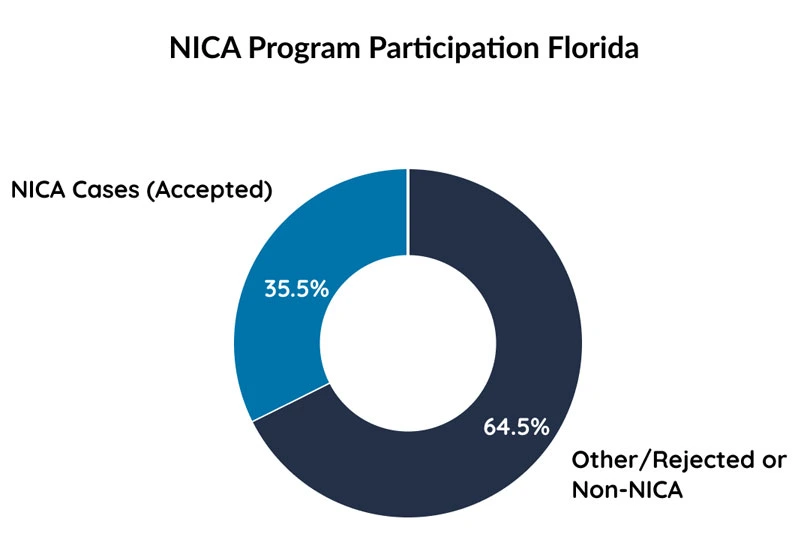
Does This Mean Florida Avoids HIE Lawsuits?
Not entirely.
While NICA does divert a significant number of cases out of the legal system, it does not eliminate litigation. Not every case qualifies for NICA, and some families decline participation, especially if they believe the injury doesn’t meet NICA’s criteria, or if they wish to pursue broader claims of medical negligence.
In those instances, traditional malpractice litigation still occurs. And when it does, the stakes are high.
In 2022, Florida reported $382 million in total medical malpractice payouts, the second-highest total in the country, behind only New York. This reflects both Florida’s large population and its litigation-heavy medical environment, particularly in areas like obstetrics.
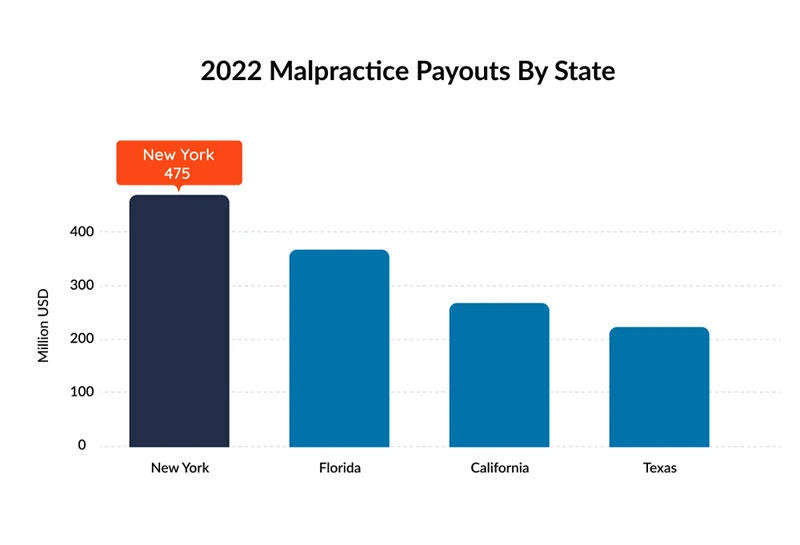
Although HIE-specific case counts aren’t publicly tracked, experts estimate that dozens of HIE-related malpractice claims arise annually in Florida. Many of these are settled before trial, but some reach court and result in major verdicts.
One striking example: a Miami obstetrician, working at a federal clinic, faced three separate HIE lawsuits in a single year (2013). One of those cases went to trial and resulted in a $33.8 million jury award in 2017. Other Florida cases have seen multi-million dollar verdicts for infants who developed cerebral palsy or severe brain injury due to alleged negligence during birth.
HIE Settlements Are the Norm. Trials Are the Exception
Whether in Florida or nationwide, most HIE-related birth injury cases don’t go to trial. It’s estimated that around 95% of neonatal injury claims are settled out of court. These settlements are often confidential, negotiated between hospitals, insurers, and families to avoid the uncertainty and expense of a jury trial.
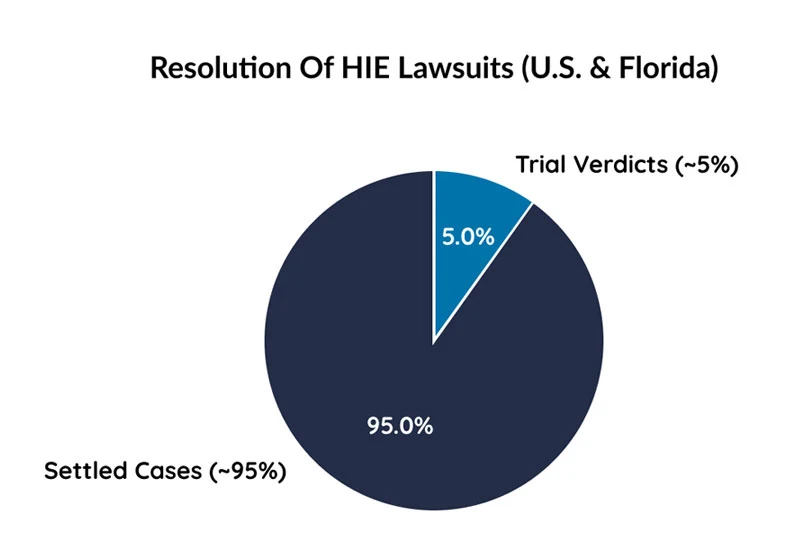
In Florida, HIE continues to be a significant cause of neonatal morbidity, often resulting in prolonged NICU stays and long-term disability among survivors, according to the Florida Department of Health’s 2024 report on infant mortality. However, the presence of NICA also shifts the legal strategy. If a child’s injury qualifies under NICA, the case is handled through an administrative process, not a lawsuit. If a family opts out or the injury doesn’t meet NICA’s criteria, litigation may proceed.
Significantly, recent reforms have expanded the benefits NICA provides, including an increase in the parental award to $250,000, which may further reduce the motivation for families to pursue lawsuits instead.
However, when a case does go to trial, the financial stakes are enormous. Because Florida’s caps on non-economic damages were ruled unconstitutional in 2017 (for wrongful death cases), there are no limits on “pain and suffering” damages in catastrophic injury cases like HIE. That contributes to higher settlement demands and sometimes eight-figure verdicts.
Average Payouts and the Financial Impact of HIE Cases
So, what does the average HIE settlement look like?
While figures vary by case and state, most estimates suggest that the national average for HIE-related settlements is around $1 million or more. Given Florida’s legal landscape and the absence of damage caps in HIE cases, Florida’s average payout likely meets or exceeds this national benchmark.
For insurers and hospitals, this creates a powerful incentive to settle early and avoid trial. For families, it’s often a question of weighing the certainty and speed of a settlement or NICA claim against the length, cost, and risk of a lawsuit.
At the heart of the issue is the human cost of HIE and the need to prevent these injuries from happening in the first place. HIE litigation reflects not just legal questions, but deep emotional and financial burdens carried by families.
Whether handled through court settlements, jury trials, or NICA claims, these cases underscore the importance of:
- High-quality obstetric care
- Early detection of fetal distress
- Robust monitoring during labor
- Immediate intervention to prevent brain injury
Ultimately, while Florida’s NICA program offers a unique approach to compensation, HIE remains a critical medico-legal issue nationwide. Preventing it through better care, education, and oversight remains the best solution for protecting both families and providers.
The Legal and Financial Weight of Neonatal HIE in the U.S.
While Hypoxic-Ischemic Encephalopathy (HIE) is first and foremost a devastating medical condition, it is also one of the most legally and financially complex issues in pediatric healthcare. HIE cases often lead to litigation due to the severity of injury, the high cost of lifelong care, and the availability of detailed medical records, all of which contribute to high-stakes malpractice claims.
In Florida, this challenge is compounded and complicated by the state’s dual-track system for birth injury compensation, with most families navigating either the NICA program or the civil litigation system.
Birth Injury Lawsuits: Why Neonatal HIE Tops the List
National data clearly shows that neonatal malpractice claims, especially those involving HIE, are the most expensive and complex among all pediatric age groups.
A 9-year review of 1,215 pediatric malpractice claims found:
- 37% resulted in a financial payout.
- The average payout across all age groups was $630,000.
- The average cost to defend a claim was $158,000.
But neonatal cases involving infants injured around birth stood out:
- Average payout: $937,000 (the highest among all pediatric age groups).
- Median payout: $300,000 (a more typical scenario, excluding outliers).
- Average defense cost: $187,000.
- Median defense cost: $119,000.
In comparison, claims involving teenagers had much lower payouts:
- Average: $387,000
- Median: $162,500
These figures illustrate the unique financial exposure that birth injury claims present for hospitals and insurers, and for families who may face a lifetime of medical and developmental needs.
Why Are Neonatal HIE Cases So Costly?
Several factors explain why HIE-related litigation is especially expensive:
- Lifelong care needs: Many children with moderate or severe HIE will require round-the-clock care, physical and occupational therapy, medical equipment, and special education services for the rest of their lives.
- Intensive early medical costs: Newborns with HIE often receive therapeutic hypothermia, require extended NICU stays, and undergo numerous interventions in the first weeks of life, all of which raise treatment costs immediately.
- Emotional and family burden: Courts and insurers recognize that HIE affects entire families, not just the child. Compensation often reflects the broader impact on quality of life and caregiving responsibilities.
- Legal complexity: These cases typically involve multiple providers, electronic fetal monitoring data, and precise medical timelines. This level of documentation can strengthen causation claims, but also makes them expensive to litigate and defend.
Florida’s Dual System: NICA and the Tort System
Florida is unique among U.S. states in offering two separate pathways for families affected by birth-related neurological injuries:
NICA (Birth-Related Neurological Injury Compensation Association)
Established in 1988, NICA provides lifetime medical care and a $250,000 statutory award to families of infants with catastrophic birth injuries like severe HIE. In exchange, families waive their right to sue.
Traditional Malpractice Litigation
For cases that don’t qualify for NICA or where alleged negligence falls outside the scope of neurological injury, such as delayed intervention or failure to monitor, families may pursue civil lawsuits.
As of early 2021:
- 1,238 petitions had been filed with NICA.
- 440 children had been accepted into the program.
This indicates that many HIE cases have been diverted from the court system. However, many others are still litigated, especially when families are ineligible or opt out of NICA.
The Limits and Controversies of Florida’s NICA
While NICA was designed to reduce litigation and stabilize OB/GYN malpractice premiums, it is not without controversy:
- Eligibility criteria are strict, and some families find themselves excluded despite having children with severe neurological injuries.
- Damages in NICA cases are capped, which means families cannot seek compensation for pain and suffering or lost quality of life, unlike in civil court.
- The standard $250,000 award is modest compared to multimillion-dollar settlements won through litigation.
This has led to questions about fairness and adequacy, especially when families with similar injuries receive vastly different compensation based solely on whether the case qualifies for NICA.
Florida medical malpractice attorneys must carefully assess each case early, as opting into NICA may bar traditional lawsuits, even if other forms of negligence occurred.
Why Florida’s HIE Legal Landscape Matters
Complex medical realities, significant financial risks, and a unique legal framework shape HIE litigation in Florida. While national data shows neonatal claims are the most expensive pediatric cases, Florida’s NICA system introduces a distinct layer of difficulty, both in terms of legal strategy and in questions of fairness.
Despite medical advances, the rate of HIE in Florida remains steady, NICU admissions are rising, and malpractice payouts remain high. This suggests that prevention through better obstetric monitoring and faster intervention must remain the focus moving forward.
Whether through NICA, settlement, or courtroom litigation, the stakes in HIE cases remain as high as ever because behind every claim is a child, a family, and a lifelong journey shaped by a single moment during birth.
Risk Factors for HIE: Clinical and Systemic Contributors
HIE is typically caused by a disruption in oxygen or blood flow to the infant’s brain during critical periods before, during, or immediately after delivery. The following are key clinical risk factors, many of which are common in Florida birth injury cases:
- Placental abruption
- Umbilical cord compression or prolapse
- Maternal anemia or infection
- Preeclampsia and other hypertensive disorders
- Cephalopelvic disproportion
- Induction and augmentation of labor with oxytocin
- Prolonged labor including prolonged second stage of labor
- Delayed recognition of fetal distress
While these risk factors are medically recognized, the failure to act upon them, such as a delay in ordering an emergency cesarean section, frequently forms the foundation of malpractice allegations. In Florida, particularly within busy urban hospitals and federal OB clinics, breakdowns in communication or understaffing may exacerbate the risk.
Although precise statewide data on the frequency of these risk factors is not readily available, the outcomes from litigation and hospital case reviews indicate that delayed response to abnormal fetal heart tracings is one of the most litigated missteps.
Medical Response and Treatment Protocols in HIE
The standard of care for suspected moderate to severe HIE includes immediate transfer to a Level III or IV NICU and the initiation of therapeutic hypothermia within six hours of birth. Most major hospitals in Florida have protocols in place for rapid recognition and initiation of this treatment. Cooling therapy has been shown to reduce both mortality (from ~12% to 8%) and long-term neurodevelopmental disability.
Florida’s NICU capacity is robust, especially in large academic and regional medical centers. However, missed windows for cooling due to delayed recognition or failure to escalate care are not uncommon in litigation filings.
In malpractice claims, failure to:
- monitor fetal distress,
- order a timely cesarean,
- or initiate cooling promptly
are cited as direct breaches of the standard of care.
How Freidin Brown, P.A., Helps Parents Go Through HIE Litigation in Florida
When your newborn suffers from HIE, the future changes in an instant. You need clarity. You need answers. And you need a law firm that has the skill, time, and commitment to fight for justice on your behalf.
At Freidin Brown, P.A., we understand that HIE cases are not only legally and medically complex but deeply personal. Families dealing with an HIE diagnosis often deal with grief, fear, and enormous long-term care needs. That’s why we’ve built our practice around supporting clients through the most challenging moments of their lives with elite trial strategy, personalized attention, and the resources of a major firm.
The Freidin Brown Advantage in HIE and Birth Injury Cases
We don’t take hundreds of cases a year like billboard firms. Instead, we carefully select every case, so we can devote the full weight of our team to your child’s outcome.
- Every medical malpractice case is overseen by Philip Freidin, who has over 50 years of experience and is Board Certified in Civil Trials by the Florida Bar.
- Our medical malpractice trial attorneys have conducted more than 300 jury trials, including over 200 led by Mr. Freidin himself.
- At least two attorneys, plus a dedicated paralegal, collaborate on the strategy and litigation plan for every case.
- We work with a nationwide network of medical experts, nurses, and neonatologists to build robust timelines and causation arguments in HIE cases.
- The firm uses cutting-edge courtroom technology and regularly consults with medical professionals on fetal monitoring and neonatal neurology.
Freidin Brown, P.A., Has a Reputation Built on Results
At Freidin Brown, P.A., results are about lives changed, futures protected, and justice pursued with precision and passion. For over four decades, our attorneys have built a reputation throughout Florida as trusted legal advocates in some of the most challenging and high-stakes medical malpractice cases, including those involving birth injuries like HIE.
We are proud to be recognized for our legal victories and the relationships we build with clients who need a legal team that will stand with them from the moment they pick up the phone to the moment a judgment or settlement is delivered.
We know that families facing an HIE diagnosis are looking for someone who will fight for their child’s future with compassion, integrity, and unwavering dedication. That’s what we offer at Freidin Brown, P.A. Our reputation was built on the trust of families who allowed us to stand by their side. When the stakes are this high, you deserve a team that treats your case like it’s the only one that matters, because to you, it is.
Our Birth Injury Lawyers Stand with You
NICA may offer a path to compensation, but it does not provide accountability, it does not deliver full justice, and it does not replace the power of the courtroom. When a preventable injury changes the course of a child’s life, families deserve more than a capped award and a closed file. They deserve answers. They deserve advocacy. And in many cases, they deserve to be heard in front of a jury.
At Freidin Brown, P.A., we are trial lawyers. When hospitals fail, when protocols are ignored, and when families are left with silence and loss, we build the case, bring the experts, and take it to court. From your first call to the day of court judgement – if that’s where your case must go – we will prepare, litigate, and advocate with the same relentless focus and trial-tested strategy that has defined our success across hundreds of medical negligence cases.
Legal Reform and Clinical Vigilance Must Advance Together
HIE in newborns remains one of the most devastating and costly outcomes in perinatal medicine, medically, financially, and emotionally. This five-year overview makes clear that while therapeutic interventions have improved outcomes for many infants, systemic risks remain entrenched, particularly in high-volume hospital settings and underserved areas of Florida.
On the legal front, Florida’s dual-track system, which allows both NICA claims and civil litigation, creates a complex and sometimes uneven landscape for families. While NICA provides timely, guaranteed care for qualifying cases, it limits broader accountability and caps certain damages. On the other hand, traditional litigation remains essential in cases where negligence is suspected but falls outside NICA’s narrow eligibility.
Ultimately, HIE prevention and justice require an integrated approach:
- Clinical vigilance and immediate response protocols
- Clear communication and staffing in obstetric units
- Legal frameworks that balance efficiency, fairness, and accountability
For policymakers, attorneys, and physicians, this data highlights the need for ongoing improvement in both care delivery and the legal mechanisms designed to protect Florida’s most vulnerable citizens.
FAQs: Understanding Neonatal HIE, Malpractice, and Florida’s Legal Landscape
If your child has been diagnosed with HIE, you likely have questions that go beyond statistics and legal codes. Below, our Florida birth injury lawyers address some of the most common and urgent concerns families face when navigating the complex intersection of birth injury, hospital accountability, and compensation.
What is the difference between NICA and a medical malpractice lawsuit in Florida?
NICA is a no-fault compensation program offering lifetime medical care for eligible children with catastrophic birth injuries like HIE. However, families who accept NICA benefits waive their right to sue. A medical malpractice lawsuit handled by a Florida birth injury attorney from our firm enables families to pursue higher compensation, including damages for pain and suffering, when negligence is suspected.
Can you sue a hospital for HIE in Florida if the case qualifies for NICA?
In most cases, no. If your child is accepted into NICA, you are not allowed to file a lawsuit. However, if the injury doesn’t meet NICA’s criteria or if negligence occurred beyond the birth itself (e.g., delayed cooling therapy), a Florida birth injury attorney from Freidin Brown can help you evaluate whether a traditional lawsuit is still possible.
Why do most HIE lawsuits settle out of court?
Over 90% of HIE malpractice cases settle because trials are time-consuming, expensive, and unpredictable. Our Florida birth injury lawyers are skilled in negotiating high-value settlements that secure lifelong care and support. Still, we’re also prepared to take your case to trial if full justice demands it.
Does malpractice always cause HIE?
Not always. HIE can occur even with proper care. However, if your child’s injury was due to delayed intervention, failure to monitor fetal distress, or mistakes during delivery, one of our experienced Florida birth injury lawyers can investigate whether negligence played a role.
What types of damages can families recover in an HIE malpractice case in Florida?
Families may be eligible to recover compensation for medical expenses, pain and suffering, emotional trauma, future lost income, and lifelong care needs. A Florida birth injury lawyer from our firm can help you estimate your total damages and fight for every dollar your child deserves.
How does Florida compare to other states in HIE malpractice payouts?
Florida is consistently among the top states for total medical malpractice payouts. Unlike most states, Florida’s NICA system limits lawsuits for qualifying cases. Our Florida birth injury attorneys understand this dual system and can guide you through both NICA eligibility and civil litigation strategies.
What’s the average payout for HIE malpractice cases involving newborns?
The national average for neonatal HIE cases is around $1 million, but many cases — especially those involving lifelong disability — settle for far more. Our Florida medical malpractice lawyers have secured multi-million dollar results and know how to build strong, expert-supported claims.
DATA DISCLAIMER
This case study uses verified health and legal data through the end of 2023, drawn from sources including the Florida Department of Health, AHCA, and national databases. As of mid-2025, data from 2024 and early 2025 remain incomplete, as full public release typically lags due to the time required for validation and reporting. Additionally, many malpractice outcomes, particularly settlements, are confidential or unresolved, meaning the true scope and value of recent claims may not be fully captured in public records. This is not to be construed as medical advice. You should rely on your doctor.
